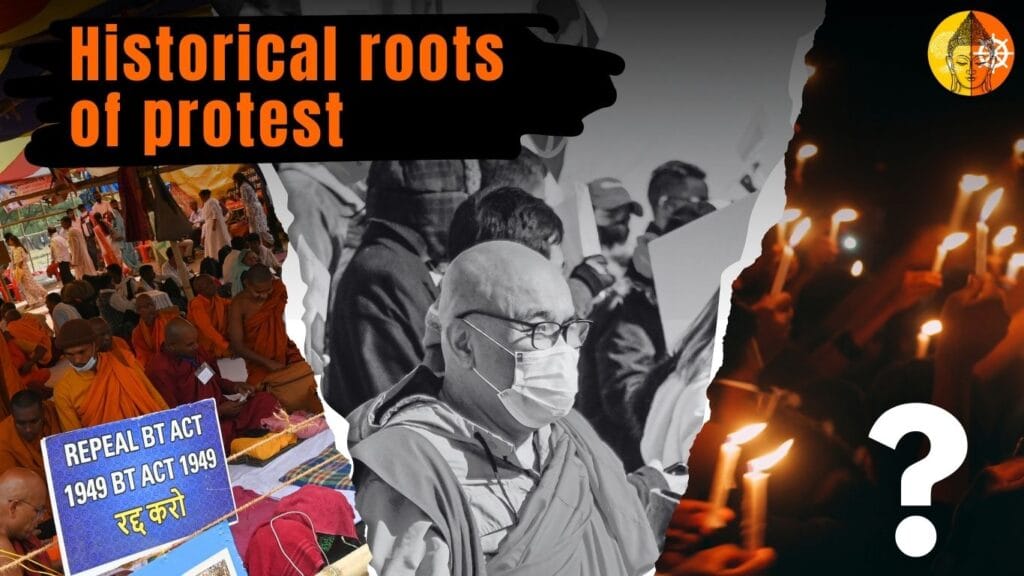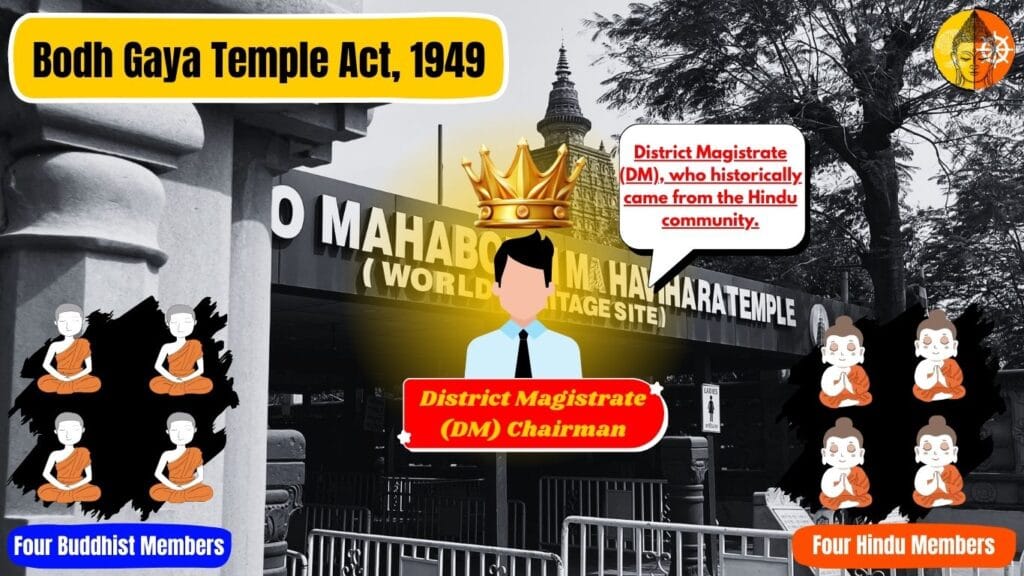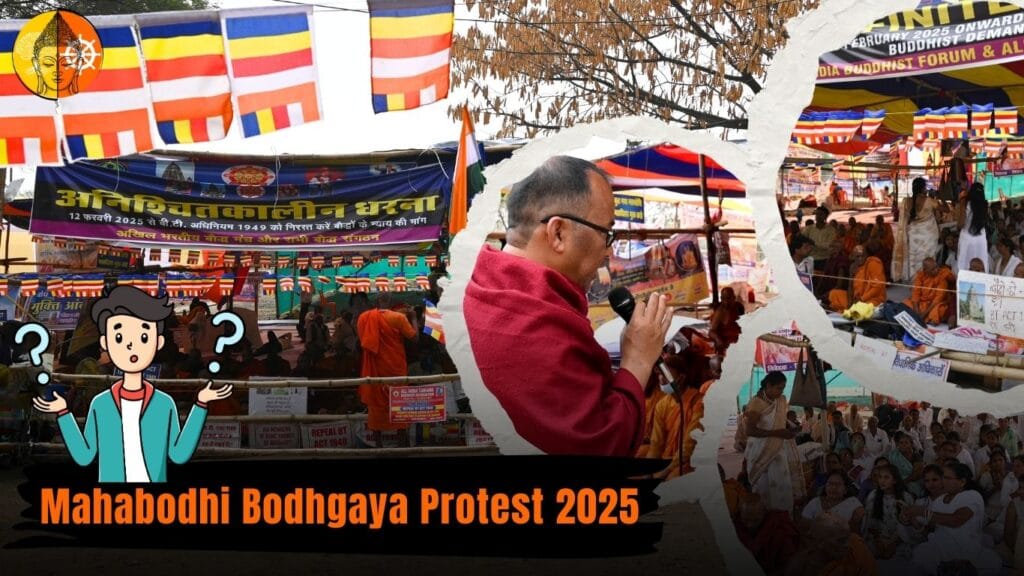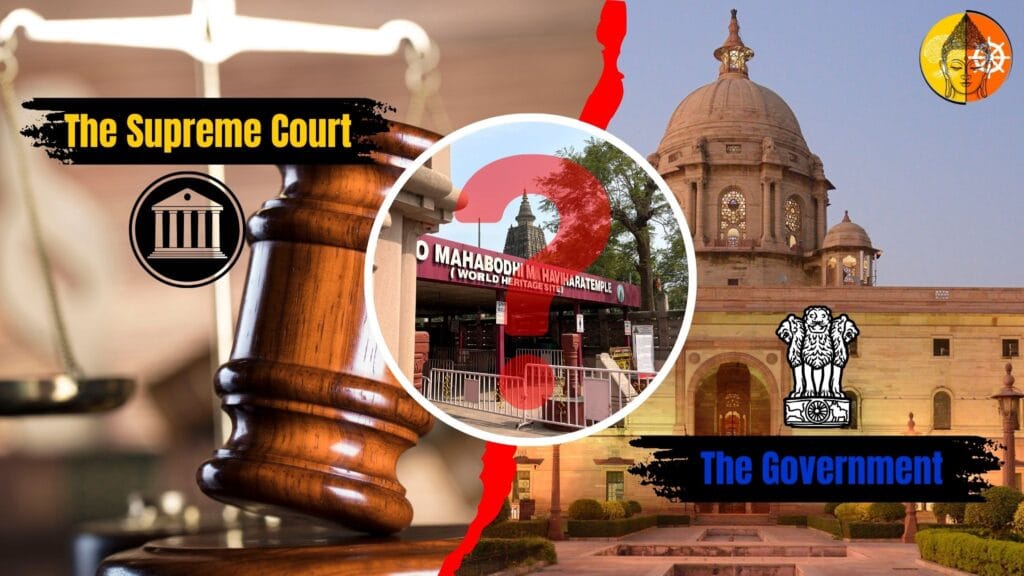The Mahabodhi Mahavihara temple in Bodh Gaya, known as the site of Lord Buddha’s enlightenment and a UNESCO World Heritage Site, has always been a hub of Buddhist worshippers, and has been in the news since early 2025 due to hunger strikes and protests by Buddhist monks and followers, which began on February 12, 2025. Several months of indefinite hunger strikes and protests have passed. Buddha Purnima 2025 is near, but the tension remains unresolved, and no effective solution has been found yet.

Historical roots of protests ;
The temple was built by the Mauryan emperor Ashoka in the 3rd century BC and was almost on the verge of collapse in the 12th century and was later revived.
Hindu guardianship: For centuries, Shaivite mahants (priests) controlled the temple, preventing Buddhists from worshipping. Hindu rituals suppressed Buddhist practices, with the Buddha statue often wrapped in Hindu symbols.
Dharmapala’s Crusade: In 1891, the famous Sri Lankan Buddhist reformer Anagarika Dharmapala visited Bodh Gaya and was deeply saddened by what he saw. He founded the Mahabodhi Society (1891) to reclaim the temple legally.

Bodh Gaya Temple Act 1949 ;
After independence, the Bihar government passed the BGTA Act and transferred control of the temple from the monks to the Bodh Gaya Temple Management Committee (BTMC).
Controversial composition: The BTMC had 4 Hindu and 4 Buddhist members, but the chairman was required to be a Hindu; Buddhists saw this as a betrayal of Gandhi’s alleged promise to return the temple after 1947.

Mahabodhi Bodhgaya Protest 2025 ;
Immediate Factors _
In February 2025 itself, the police removed more than 24 striking monks and shifted the protest site two kilometres away to Sambodhi Dwar Domuhan Bodhgaya Road.
Key Demands _
Repeal the 1949 BGTA: Activists argue that the act violates secularism (Article 25) by privileging Hindu control.
According to the Bodhgaya Temple Act 1949, the Bodh Gaya Temple Management Committee (BTMC) will have 8 members, 4 Buddhists and 4 Hindus. Under the Act, the District Magistrate (DM) of Gaya was appointed the chairman of the committee. At that time the DM was required to be a Hindu, which was changed by an amendment in 2013.
Exclusive Buddhist management: “A Buddhist temple should be run by Buddhists,” says Bhante Anand, president of the All India Bhikkhu Mahasangh (AIBMAF).
Eliminate Hindu rituals: Critics highlight Vedic chants and rituals at the temple, which they claim distort the temple’s Buddhist identity.
Colonisation of sacred places _
Activists have demanded that India follow global examples (e.g., Vatican City, Mecca, etc.) where religious sites are managed by their religious communities.
We visited the site and interviewed prominent Buddhist followers. You can watch the full interview video on our YouTube channel. Here is what they said in brief:
“Akash Lama, National General Secretary of All India Buddhist Forum, has been on an indefinite hunger strike since 12 February 2025, demanding rights for Buddhists in the management of Bodh Gaya Mahabodhi Mahavihara. His main demand is to repeal the Bodh Gaya Temple Act, 1949, according to which the Mahavihara Management Committee (BTMC) consists of 4 Buddhists, 4 non-Buddhist members and a non-Buddhist chairman. They argue that this arrangement is contrary to Article 13 of the Indian Constitution, which invalidates pre-constitutional laws that conflict with fundamental rights.
Historical background: In 1890, Anagarika Dhammapala started a movement to free the Mahabodhi site from the occupation of Hindu monks.
In 1932, Mahatma Gandhi supported handing over the site to Buddhists.
Even after the 1949 Act, the Buddhist community did not get full management rights. In 1992, a movement led by Bhante Suresh lasted for 6 years, which failed.
Current situation: After a 17-day hunger strike, the protesters were removed on 28 February.
Meetings were held with Bihar government’s Home Secretary Animesh Pandey and the National Commission for Minorities (NCM), but no concrete result came out.
In 2023, more than 50,000 Buddhists organised peace rallies on 26 January and 26 November, etc.”
Key activist groups _
AIBMAF: Leading nationwide protests with support from Thai, Japanese and Sri Lankan Buddhist groups.
Bheem Army: A Dalit rights group has joined the protests, linking the issue to social justice, making it global news rather than a Bihar and india issue.

The Supreme Court Vs The Government ;
2013 BGT amendment: The Bihar government amended it and allowed a non-Hindu district magistrate to also become the chairman of the BTMC, i.e. now the DM need not be a Hindu to become the chairman of the BTMC. But this has led to resentment among Buddhists, who call it symbolic and demand full control, as the District Magistrate (DM) of Gaya, who has historically been from the predominantly Hindu community, has made Hindus more influential than Buddhists.
Deadlock in the Supreme Court. A 2012 petition challenging the constitutionality of the BGTA is still pending. BTMC secretary Mahasweta Maharathi said the matter is sub-judice, while protesters accused authorities of delaying justice as the case has not been heard even after a long time.
Political reactions, BJP: Silent on the issue, fearing it will influence Hindu voters. Bihar is due to have a chief ministerial election this year, but incumbent chief minister Nitish Kumar and other opposition leaders have not taken any concrete decision on it.
The Union Budget 2024-25 states that the Mahabodhi Temple Corridor in Bodh Gaya, Bihar, will be developed as a world-class pilgrimage and tourist destination, but no such work has even started yet.
Conclusion ;
The protest against the Mahabodhi Temple is not just about administration – it is a fight for respect, identity and the right to define one’s heritage. Since Buddhism has around 500 million followers in the world, which is 7% of the global population, it has become a global issue and not just an India or Bihar issue. Also, India has a global reputation as a secular nation, so this becomes even more relevant as it will also impact the global identity of our country. Finally, I conclude with a big thank you and gratitude to you. Also, please comment and let us know where you are reading this article from, what your opinion is on it, etc.

